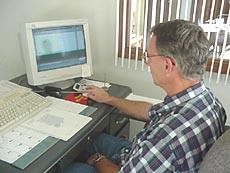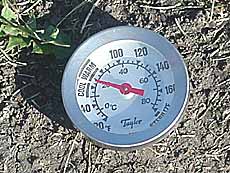|
[click here for Part 1]
Farmers
have many options open for applying nitrogen. They can apply their total crop
needs all in the fall, split the applications between fall and spring, or wait
to do it all in the spring. They can also choose between applying ammonium
sulfate, anhydrous ammonia, or liquid nitrogen at a 28 percent concentration. All
decisions come with a different price tag and different environmental
considerations.

Professional
agronomists from the University of Illinois, along with fertilizer trade
associations, encourage dealers like Herrin Fertilizer to follow strict
environmental stewardship standards as they make fertilizer recommendations. The
Illinois Fertilizer and Chemical Association says that application of fall
nitrogen is the biggest stewardship issue facing the fertilizer industry at the
moment. They are urging farmers to put off applying any kind of nitrogen source
until the soil temperature at the 4-inch level is below 60 degrees with
stabilizers or below 50 degrees without stabilizing agents. They have
established a website at www.ifca.com/soiltemps.htm
to inform farmers across the state of soil temperatures in their area.
Under
warm, moist conditions, soil microbes are actively breaking down the ammonium
form of nitrogen into nitrates. The nitrate form is very susceptible to leaching
into groundwater after heavy rains move it down through the soil profile. When
temperatures drop below 50 degrees, the microbial activity slows significantly,
and unstabilized nitrogen stands a better chance to bond firmly to soil
particles until spring.

Central
Illinois farmers who choose to apply anhydrous ammonia in the fall are
encouraged to add N-Serve nitrogen stabilizer to every load. N-Serve works
against the soil bacteria that break down nitrogen into leachable nitrates. By
using N-Serve, farmers can legally apply nitrogen when the soil temperature is
higher than 50 degrees without worrying that all the usable nitrogen will be
gone by spring.
[to top of second column in
this section]
|

Anhydrous
can be a very dangerous product for a dealership to handle. Physical contact
with anhydrous can cause serious burns to the skin and eyes, while inhalation
can seriously damage one’s lungs. Laws that regulate use of anhydrous ammonia
are becoming tighter. This year, all farmers that are transporting anhydrous
nurse tanks must carry permanent shipping papers with the tank ID number and
weight.
Dealerships
that handle anhydrous ammonia usually deal with some big headaches throughout
the season. They must maintain the toolbars (application tools used to apply
anhydrous into the soil). If the ground is hard, then toolbars are more likely
to break. Now they must also be concerned with methamphetamine producers
siphoning off anhydrous from nurse tanks to produce addictive drugs.
To
eliminate some of these hassles, Herrin Ltd. promotes the use of ammonium
sulfate as a nitrogen source. Ammonium sulfate is a byproduct of lysine
production at ADM in Decatur and resembles a dark brown cooking oil. Since ADM
has no use for the ammonium sulfate, they sell it for a cheap price to
dealerships that are located near Decatur. Herrin Ltd. recently built a
one-million-gallon tank to hold the product. The product has become popular with
farmers because they can hire Herrin Ltd. to apply the ammonium sulfate for
them. In years with higher fuel prices, this saves farmers a lot of money.
The final
option for fertilization is liquid 28 percent nitrogen. This product either has
to be rained on or mechanically worked into the soil within a week following
application. Many farmers supplement their fall fertilization activities with 28
percent in the spring, since it can be applied with chemicals in one application
round. Like ammonium sulfate, there is no real way to stabilize the nitrogen in
28 percent, so farmers must be extra aware of the environmental hazards of
having too much rain on fields that have already been fertilized.
[Marty
Ahrends]
|
|
At
Herrin Fertilizer in Mount Pulaski, Rich Fulscher and John Bishop have been
taking soil samples and creating customized fertilization maps for each of their
customers’ fields. From the information on these maps, Rich and John are able
to tell their customers how many pounds of nitrogen, phosphate, potash and lime
should be applied to each acre this fall.

[John Bishop makes field maps at the computer.]
The
soil fertility principles followed at Herrin Fertilizer emphasize that the pH
must first be balanced to ensure that all other nutrients are working in
harmony. The quick fix to neutralize high pH soils is ag lime. Spreader trucks
with monstrous tires spread this white trail of dust across fields. Winter
precipitation in the forms of rain or snow will break down the ag lime and
enable it to start working on the soil.

Without
pH balanced soils, other investments in nutrients are likely a waste of time and
money. Fields with a pH that is too high or too low will later experience
problems with availability of chemicals and micronutrients. If the pH is too
high, chemicals might become too available for plant uptake and cause serious
yield damage. Conversely, a low pH could keep a herbicide from working and allow
weeds and grasses to interfere with growth of the crop.

[Rich Fulscher weighs trucks.]
[to top of second column in
this section]
|

Liming
is not necessarily recommended on every field every year. However, since
high-yielding crops take a lot of key nutrients out of the soil each season,
fall applications of nitrogen, phosphate and potash are standard fare. For
example, a 50-bushel-per-acre soybean crop this fall removed 70 pounds of
potassium and 40 pounds of phosphorus from each acre. Those nutrients must be
replenished so that next year’s crop will be healthy.

[Soil thermometer]
Applying
fertilizer in the fall helps eliminate the need to run heavy application
equipment over typically wet fields in the spring, which creates serious
compaction problems. Since fields are usually dry and firm in the fall, there is
little concern that compaction will occur. Any compaction that does occur should
be corrected by the normal wet and dry, freezing and thawing cycles that occur
throughout the winter.

Just because
the fields are fit doesn’t mean that dealerships like Herrin’s can apply
lime and fertilizer every day. When the wind blows in excess of 15 miles per
hour, all application of dry products must cease.
(To
be continued)
[Marty
Ahrends]
[click here for
Part 2]
|
|
Hartem
team places fifth in national FFA competition
 [NOV.
2, 2000]
The
Hartem FFA Ag Issues team placed fifth out of 27 teams at the recent National
FFA Convention competition. The team members — Kate Wrage, Matt Duckworth,
Sarah Struebing, Nick Reinhart, Anthony Jones, Nic Coers and Natalie Coers —
presented a forum on genetically modified organisms. [NOV.
2, 2000]
The
Hartem FFA Ag Issues team placed fifth out of 27 teams at the recent National
FFA Convention competition. The team members — Kate Wrage, Matt Duckworth,
Sarah Struebing, Nick Reinhart, Anthony Jones, Nic Coers and Natalie Coers —
presented a forum on genetically modified organisms.
The
team advanced through the preliminaries and into the semifinal rounds. By going
this far, the team ranked as a National Silver Emblem winner.
While at the
convention, the team, along with Hartem FFA members Daniel Eeten and Brittney
Kavanaugh, heard keynote speaker Debra Norville and witnessed the naming of the
American Star Farmer and American Star in Agribusiness, besides taking time to
tour the Agriculture Career Show.

[Left to right: Nick Reinhart, Natalie Coers, Anthony Jones
Kate Wrage, Sarah Struebing, Matt Duckworth and Nic Coers]
|